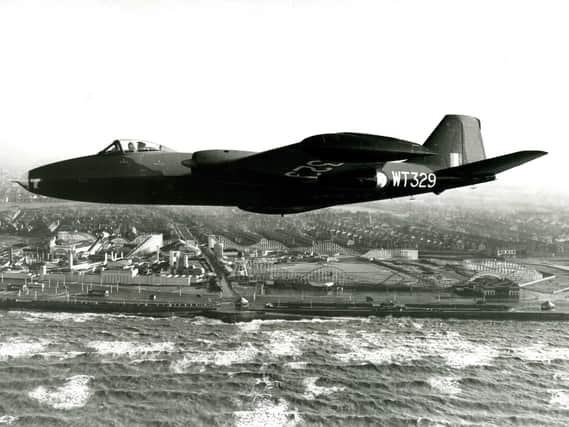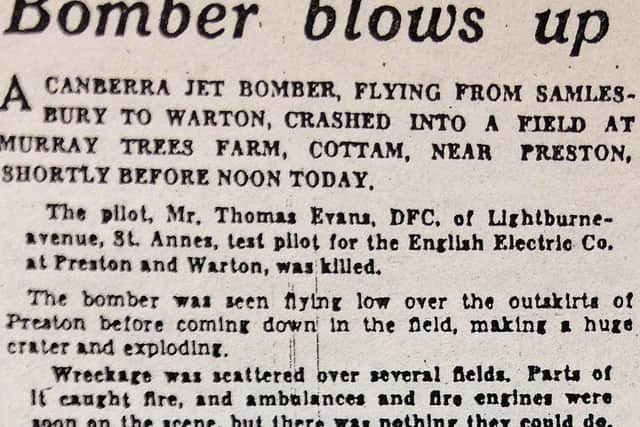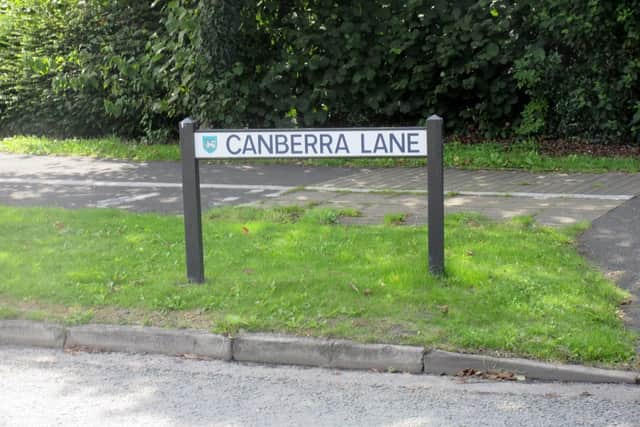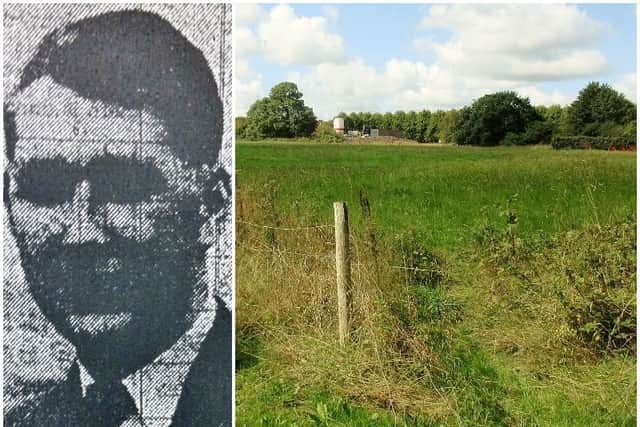Tragic air crash in Preston field


The plane was observed flying low over the outskirts of Preston before exploding on landing, leaving a huge crater. Wreckage was scattered over several fields and parts of it were soon ablaze. Despite the early arrival of ambulances and fire engines there was little they could do as they discovered the body of the pilot Thomas Benjamin Evans who was killed instantly.
Flt Lt Evans, 29, a resident of St Annes, was married with three children and had been a test pilot with the English Electric Company for four years. Regarded as a highly skilled operator he had the previous year demonstrated his aerobatics with the Canberra bomber at the Farnborough Air Show before a crowd of more than 150,000. It was described at the time as a breathtaking spectacle which overshadowed the other aircraft.
Advertisement
Hide AdAdvertisement
Hide AdA cottage on the side of the road opposite the field had its front windows smashed and a hole left in the roof by flying debris. The occupier, Mrs Billington, had been out at the time, only returning later to see the devastation.


An inquest was opened in Preston later in the week when English Electric chief test pilot Rowland Beamont gave evidence of identification. He confirmed a gold signet ring taken from the body, and identified by Flt Lt Evans’ widow, belonged to the pilot. He stated it was the first flight of this particular aircraft and that he had spoken to Flt Lt Evans on the airfield at Salmlesbury before take off.
John Ball, an aircraft fitter, was then called and he recalled helping strap Flt Lt Evans into the aircraft and securing his parachute. He observed that it was a normal take off and the pilot was in good spirits. Proceedings were then adjourned for a month.
The funeral of Flt Lt Evans took place a week later at Lytham Cemetery following a service at St Thomas’s Church in St Annes. Besides his widow and family mourners there were many present from the English Electric Company. The coffin was draped with the Union Jack and a wreath in the form of a Canberra twin-jet bomber was laid. In late April the inquest was resumed and it was reported that examination of the debris of the Canberra twin engine jet had not disclosed any defects.
Advertisement
Hide AdAdvertisement
Hide AdFlt Lt Squires was called and he speculated that there could be two possible reasons why the deceased had not used his parachute before the crash. He was either making sure the plane did not crash on nearby homes or, if he was not flying very high and ran into trouble, he would not have had time to bail out. Some witnesses testified that black smoke streamed from the plane as it went down.


Others stated there was only a wisp of a cloud of smoke and a flash as the plane crashed. Hundreds of people had observed the aircraft flying over at 1,500ft and it was recalled by one witness that it took a long steep dive, flashed over houses in Woodplumpton Road and then plunged into the field.
Thomas Duncan, an air traffic control officer, of Tag Lane, had also been a witness and in his statement to the Lancashire Constabulary he recalled, “Whilst in my sitting room I heard the sound of an approaching aircraft. I thought the aircraft was flying low and going very fast. The engine was not as rhythmical as usual and had a burbling sound.
“As the plane passed overhead the engine cut out. I went outside to see what was the matter and I saw black smoke coming from a spot half a mile away in a westerly direction. I immediately contacted Barton Hall.”
Advertisement
Hide AdAdvertisement
Hide AdIt was reported that it was the first Canberra bomber to crash in thousands of hours of test flying from Salmlesbury and Warton, and only the third Canberra crash since they went into production. One had previously crashed in the Midlands on a test flight from the Rolls-Royce works and another had blown up in the United States during trials.


The coroner Mr Blackhurst said there was not enough evidence to show under what circumstances the aircraft came to crash. In conclusion an open verdict was recorded.Further investigations followed into the tragic flight and eventually a broken box spanner found in the wreckage was identified as the likely cause of the crash. It was thought this spanner had got tangled in the mechanism preventing movement of the control column, thus disabling elevator adjustments. The box spanner had eventually become trapped between three points leaving it bent and cracked.
Within days of the Cottam crash another Canberra jet exploded and crashed in Lincolnshire, killing all three crew members on board. And in December 1952 a further tragedy took place when a Canberra jet crashed while landing in a field near Grimsby, claiming the lives of three young pilots.
Despite all these awful early tragedies the Canberra developed by English Electric, introduced to service by the RAF in 1951 as their first jet powered bomber, became a popular aircraft. The area of the accident site at Cottam is now the place of a new housing development leaving no traces of the devastation on that day in 1952, although one of the new roads in the area is called Canberra Lane.